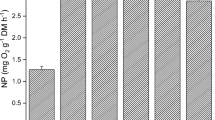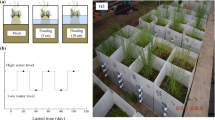Abstract
Light, temperature, and the availability of carbon are three major drivers of submerged plant growth, photosynthesis, and competitive strength. A laboratory study using a three factorial experimental design (light × temperature × CO2) was carried out to evaluate growth responses (RGR (relative growth rate), LDMC (leaf dry matter content), and root:shoot ratio) and physiological changes (pigment characteristics and net photosynthesis under CO2 depletion) in the European native Myriophyllum spicatum and the non-native invasive M. heterophyllum to changes in the three variables. Both species showed temperature optima of 21°C and highest growth rates under high-light and high CO2 conditions. Additionally, the capacity of both to use \({\text{HCO}}_{3}^{ - }\) was significantly higher in plants acclimated to CO2 depletion than for plants growing in CO2-rich water. Summarizing, both species showed their ability to grow under variable conditions, but M. spicatum is the better \({\text{HCO}}_{3}^{ - }\) user and showed better acclimation in growth and physiological parameters to CO2 depletion. Overall, native M. spicatum reached higher growth rates and showed a better acclimation to low CO2 conditions than the non-native M. heterophyllum. Thus, the \({\text{HCO}}_{3}^{ - }\) use capacity alone cannot explain the success of evergreen M. heterophyllum in formerly M. spicatum-dominated waters.





Similar content being viewed by others
References
Barko, J. W. & R. M. Smart, 1981. Comparative influences of light and temperature on the growth and metabolism of selected submersed freshwater macrophytes. Ecological Monographs 51: 219–235.
Barko, J. W. & G. J. Filbin, 1983. Influences of light and temperature on chlorophyll composition in submerged freshwater macrophytes. Aquatic Botany 15: 249–255.
Bowes, G., 2011. Single-cell C4 photosynthesis in aquatic plants. In Rhagavendra, A. S. & R. F. Sage (eds), Advances in Photosynthesis, Vol. 32., C4 photosynthesis and related CO2 concentrating mechanisms Springer, Dordrecht.
Bowes, G. & M. E. Salvucci, 1989. Plasticity in the photosynthetic carbon metabolism of submerged aquatic macrophytes. Aquatic Botany 34: 233–266.
Casati, P., M. V. Lara & C. S. Andreo, 2000. Induction of a C4-like mechanism of CO2 fixation in Egeria densa, a submerged aquatic species. Plant Physiology 123: 1611–1621.
Cook, C. D. K., 1985. Range extensions of aquatic vascular plant species. Journal of Aquatic Plant Management 23: 1–6.
Elger, A. & D. Lemoine, 2005. Determinants of macrophyte palatability to the pond snail Lymnaea stagnalis. Freshwater Biology 50: 86–95.
Eusebio Malheiro, A. C., P. Jahns & A. Hussner, 2013. CO2 availability rather than light and temperature determines growth and phenotypical responses in submerged Myriophyllum aquaticum. Aquatic Botany 110: 31–37.
Färber, A., A. J. Young, A. V. Ruban, P. Horton & P. Jahns, 1997. Dynamics of xanthophyll-cycle activity in different antenna subcomplexes in the photo-synthetic membranes of higher plants: the relationship between zeaxanthin conversion and nonphotochemical fluorescence quenching. Plant Physiology 115: 1609–1618.
Fornoff, F. & E. M. Gross, 2014. Induced defense mechanism in an aquatic angiosperm to insect herbivory. Oecologia 175: 173–185.
Garnier, E., B. Shipley, C. Roumet & G. Laurent, 2001. A standardized protocol for the determination of specific leaf area and leaf dry matter content. Functional Ecology 15: 688–695.
Grace, J. B. & R. G. Wetzel, 1978. The production biology of Eurasian watermilfoil Myriophyllum spicatum L.: a review. Journal of Aquatic Plant Management 16: 1–11.
Hussner, A., 2008. Ökologische und ökophysiologische Charakteristika aquatischer Neophyten in Nordrhein-Westfalen. Dissertation, Heinrich-Heine-Universität Düsseldorf.
Hussner, A., 2012. Alien aquatic plants in European countries. Weed Research 52: 297–306.
Hussner, A., H. P. Hoelken & P. Jahns, 2010a. Low light acclimated submerged freshwater plants show a pronounced sensitivity to increasing irradiances. Aquatic Botany 93: 17–24.
Hussner, A., K. van de Weyer, E. M. Gross & S. Hilt, 2010b. Comments on increasing number and abundance of non indigenous aquatic macrophyte species in Germany. Weed Research 50: 519–526.
Hussner, A., D. Hofstra & P. Jahns, 2011. Diurnal courses of net photosynthesis and photosystem II quantum efficiency of submerged Lagarosiphon major under natural light conditions. Flora 206: 904–909.
Klee, O., 1998. Wasser untersuchen. Quelle & Meyer, Wiesbaden.
Lara, M. L. & C. S. Andreo, 2005. Photosynthesis in nontypical C4 species. In Pessarakli, M. (ed.), Handbook of Photosynthesis, 2nd ed. Taylor & Francis, Baton Rouge.
Lebreton, A., 2013. Myriophyllum heterophyllum Michaux (Haloragaceae) in Haute-Vienne (Limousin, France), and status of this invasive plant in France and Europe. EPPO Bulletin 43: 180–192.
Maberly, S.C. & T.V. Madsen, 1998. Affinity for CO2 in relation to the ability of freshwater macrophytes to use \({\text{HCO}}_{3}^{ - }\). Functional Ecology 12: 99–106.
Maberly, S. C. & T. V. Madsen, 2002. Freshwater angiosperm carbon concentrating mechanisms: processes and patterns. Functional Plant Biology 29: 393–405.
Madsen, T. V. & K. Sand-Jensen, 1991. Photosynthetic carbon assimilation in aquatic macrophytes. Aquatic Botany 41: 5–40.
Madsen, T.V., Maberly, S.C. & G. Bowes, 1996. Photosynthetic acclimation of submersed angiosperms to CO2 and \({\text{HCO}}_{3}^{ - }\). Aquatic Botany 53: 15–30.
Middelboe, A. L. & S. Markager, 1997. Depth limits and minimum light requirements of freshwater macrophytes. Freshwater Biology 37: 553–568.
Olesen, B. & T. V. Madsen, 2000. Growth and physiological acclimation to temperature and inorganic carbon availability by two submerged aquatic macrophyte species, Callitriche cophocarpa and Elodea canadensis. Functional Ecology 14: 252–260.
Poorter, H. & M. L. Navas, 2003. Plant growth and competition at elevated CO2: on winners, losers and functional groups. New Phytologist 157: 175–198.
Hoffmann, W. A. & H. Poorter, 2002. Avoiding bias in calculations of relative growth rates. Annals of Botany 80: 37–42.
Richter, D. & E. M. Gross, 2013. Chara can outcompete Myriophyllum under low phosphorus supply. Aquatic Sciences 75: 457–467.
Sand-Jensen, K., 1983. Photosynthetic carbon sources of stream macrophytes. Journal of Experimental Botany 34: 198–210.
Sand-Jensen, K., 1989. Environmental variables and their effect on photosynthesis of aquatic plant communities. Aquatic Botany 34: 5–25.
Santamaria, L., 2002. Why are most aquatic plants widely distributed? Dispersal, clonal growth and small-scale heterogeneity in a stressful environment. Acta Oecologica 23: 137–154.
Sculthorpe, C. D., 1967. The Biology of Aquatic Vascular Plants. Arnold, London.
Smart, R. M. & J. W. Barko, 1985. Laboratory culture of submersed freshwater macrophytes on natural sediments. Aquatic Botany 21: 251–263.
Spencer, W. & G. Bowes, 1990. Ecophysiology of the world’s most troublesome aquatic weeds. In Pieterse, A. H. & K. J. Murphy (eds), Aquatic Weeds—The Ecology and Management of Nuisance Aquatic Vegetation. Oxford University Press, Oxford.
Van, T. K., W. T. Haller & G. Bowes, 1976. Comparison of the photosynthetic characteristics of three submersed aquatic plants. Plant Physiology 58: 761–768.
Winkel, A. & J. Borum, 2009. Use of sediment CO2 by submersed rooted plants. Annals of Botany 103: 1015–1023.
Acknowledgments
We heartily acknowledge the excellent technical assistance of M. Graf and the helpful comments of two anonymous reviewers.
Author information
Authors and Affiliations
Corresponding author
Additional information
Guest editors: Sidinei M. Thomaz, Katya E. Kovalenko, John E. Havel & Lee B. Kats / Aquatic Invasive Species
Rights and permissions
About this article
Cite this article
Hussner, A., Jahns, P. European native Myriophyllum spicatum showed a higher \({\text{HCO}}_{3}^{ - }\) use capacity than alien invasive Myriophyllum heterophyllum . Hydrobiologia 746, 171–182 (2015). https://doi.org/10.1007/s10750-014-1976-4
Received:
Revised:
Accepted:
Published:
Issue Date:
DOI: https://doi.org/10.1007/s10750-014-1976-4




